Reduce Non-Searchable PDF File Size
A non-searchable PDF file contains images of each page instead of pages where you can select and search text. With each page stored as an image, there is often a need to control settings to reduce non-searchable PDF file size.
Non-searchable PDF files are created when documents are scanned or converted from image formats such as TIFF, PNG, and JPEG. You can view and print the file, but not edit or search the text. When you need to keep the original layout and appearance of a document, a non-searchable PDF is a good choice. This type of PDF is also a good choice when you need to protect sensitive information by preventing the selection and copying of text in the document.
If you are creating searchable PDF files, head over to Reduce Searchable PDF File Size for information on reducing searchable PDF file size instead.
In this blog, we will look at color reduction, antialiasing, compression options, and printer resolution in PDF Image Printer 12 and Raster Image Printer 12. We will explore how to use them to find a good balance between file size and image quality.
Reduce Non-Searchable PDF File Size Using Color Reduction
The first way to reduce non-searchable PDF file size is with color reduction. Each page in the PDF is an image. Images can support various color modes and bit depths. Changing the color mode and bit depth of the images in your non-searchable PDF can help reduce its file size.
Images stored in a PDF can be color, indexed color, grayscale, or monochrome (black and white). Grayscale images use only shades of gray, resulting in a smaller file size, while monochrome uses the fewest count of colors, black and white. Consider converting to greyscale or monochrome when you do not have a lot of color in your document.
When you need to keep the color in the document, play with indexed color mode and modify the bit depth. Images can be created at different bit depths, such as 8-bit, 16-bit, or 24-bit. Lower bit-depths take less space. Indexed color mode reduces the number of colors in the image palette, further reducing file size. Try dropping your color to 8-bit or even 16-bit, which can significantly reduce the file size.
Reduce Non-Searchable PDF File Size Using Image Compression
The second way to create smaller PDF files is to compress the images that make up each page. There are many different compression methods that can significantly reduce the image size. The amount of color in your documents will also come into play when choosing a compression method.
Compression methods, like LZW (Lempel-Ziv-Welch) and ZIP (Deflate) are lossless compression methods for color images. A lossless compression method compresses the image data with no loss of quality. Images with large areas of solid color and repetitive patterns compress best with LZW. On the other hand, ZIP compression can be more effective with complex images of varying colors and gradients.
Another popular compression, JPEG, is a lossy compression method. It creates a smaller file size by throwing away unnecessary data. Its smaller size comes with a trade-off in image quality. JPEG works best on documents that are mostly photos and minimal text.
Turn Off Antialiasing to Reduce Non-Searchable PDF File Size
The next action that can help reduce your PDF image size is turning off antialiasing.
Digital images consist of a grid of squares called pixels. Coloring in the pixels on the grid creates the lines, shapes, and text in the image. Straight lines look good because they align perfectly on the grid. Diagonal and curved lines and text with round shapes, however, do not line up or are shown as partial pixels. This causes jagged edges, or the staircase effect.
Adding extra pixels to make these lines and shapes appear smoother and visually appealing is called antialiasing. However, this technique comes at a cost. Adding extra pixels takes up space in the image and results in larger files.
To help reduce non-searchable PDF file size you can turn off antialiasing. You will lose some of the visual quality in the image with the trade-off of a smaller file size.
Printer Resolution and Non-Searchable PDF File Size
PDF Image Printer 12 and Raster Image Printer 12 are printers that create images instead of printing on a piece of paper. A printer always prints at a selected resolution, or dots per inch (DPI). The higher the DPI the more detailed the output.
Images also use this concept of dots per inch when creating the grid of pixels that is the image. The printer resolution determines what DPI, or number of pixels, to use when creating the image. The higher the DPI, the more pixels we need to store and the larger the file. An image with a lower DPI uses fewer pixels per inch and can result in less detail and a pixelated or blocky image.
Again, it all comes down to balancing file size to the desired level of detail and clarity.
Adjusting Color Reduction, Compression, Antialiasing, and Printer Resolution
Our image printers use printer profiles that control what type of file to create. It also includes options such as the name of the file and where to save it, as well as color reduction, antialiasing, and compression options. Printer profiles allow easy access to creating multiple different types of files.
To change the color reduction, compression, antialiasing, and resolution options in a profile, you first need to create a new profile. Alternatively, you can edit an existing personal profile you already have.
Double-click the Dashboard desktop shortcut to open the dashboard.
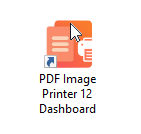
The Dashboard is your access to everything for your printer. License information, printer profile creation and editing and other tools and resources are all here. Use the Edit & Create Profiles tile to open the Profile Manager tool.
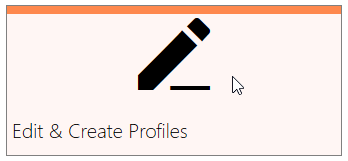
Creating and Editing Profiles
You can edit and create new profiles for the printer using the Profile Manager. We provide system profiles created by PEERNET to start you off. You can create new, personal profiles using the Add new profile button, or copy and edit existing profiles using the copy icon on the profile tile.
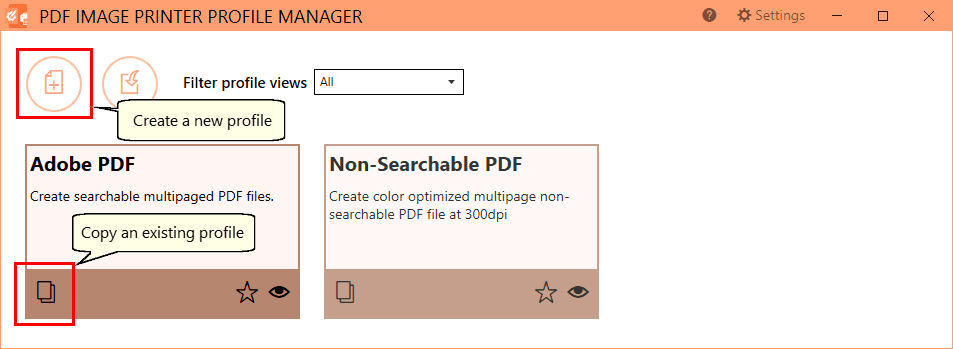
When editing a new profile or a copy of a profile, first give them a name you will remember and a short description in the fields at the top of the editor.
Change Color Reduction to Reduce Non-Searchable PDF File Size
When editing profiles, all the profile categories are available on the left-hand side, with the options for the selected category on the right.
Color reduction and antialiasing settings are in the Save Options category. These settings apply when you are creating non-searchable PDF files. To ensure we are creating non-searchable PDF files, under Output Type and Color, toggle the option Create each page as an image to on.
Then, use the drop box next to the Reduce colors to label to select your desired color reduction.
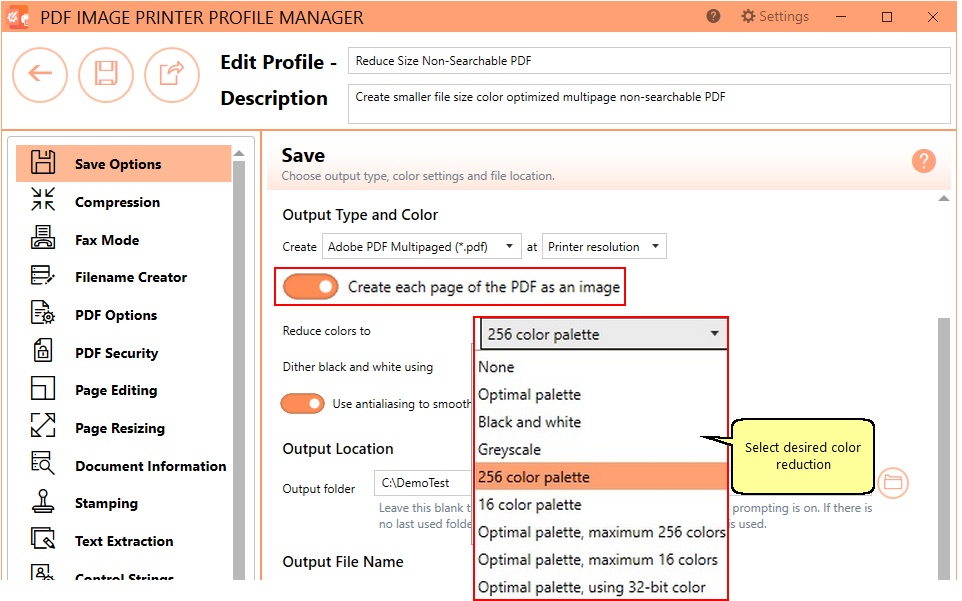
The default setting of Optimal palette means the printer reduces the image for each page down to the smallest number of colors needed. The PDF file maintains all the colors from the original file. Some pages will be full color, some 16-bit or 8-bit color, and some monochrome. Reducing color on the pages that only have a few will help decrease your file size
To further drop your file size, you can limit the colors on each page by creating 8-bit or 4-bit color images only with the 256 color palette or 16 color palette options.
To create greyscale or monochrome images instead, select Greyscale or Black and white.
You can learn more about the other color reduction options in our online user guide.
Disable Antialiasing to Reduce Non-Searchable PDF File Size
Antialiasing adds extra pixels and information to create the effect of smoother lines, curves, and shapes. These extra pixels add more data to be stored, causing the file to be larger. You can turn this option off to see how much space you will save.
Antialiasing is also in the Save Options category. It is on by default. Click on the toggle to turn it off.
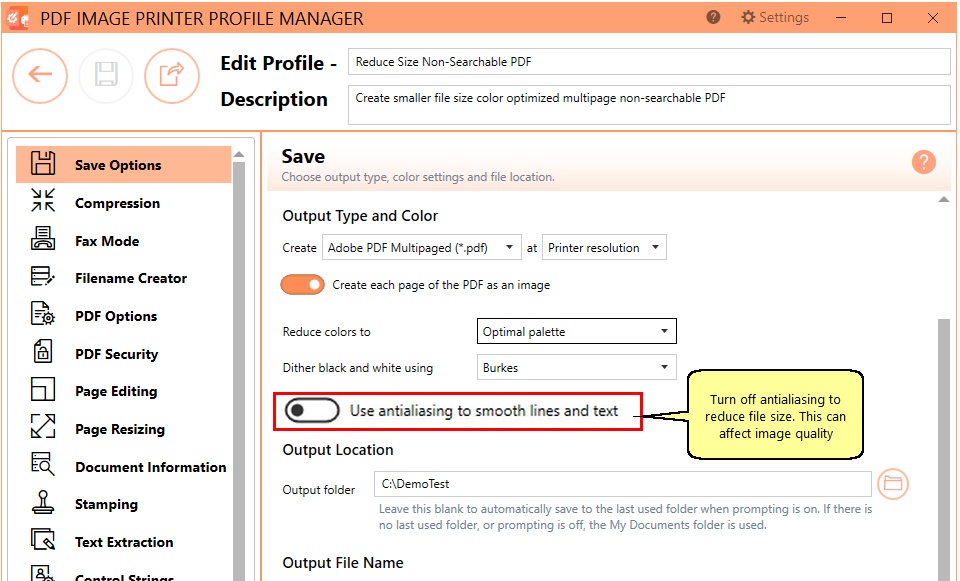
Change Compression to Reduce Non-Searchable PDF File Size
Changing the compression method used to save the images in non-searchable PDF files is another way to reduce file size. The Compression category will display the different compression options for Text and line art, Color, Indexed, Greyscale, and Monochrome images. It also allows you to create uncompressed PDF files but this is normally not recommended.
The Color reduction setting does not affect text and line art compression.
The color reduction you have chosen above determines which of the compression options apply, but does not affect text and line art compression, only images.
If you are using Optimal palette, the compression options for Color, Indexed, Greyscale, and Monochrome images can all apply to different pages as each image is reduced to its minimal number of colors.
When color reduction is Greyscale, the compression method chosen for Greyscale images is used to compress the images. Similarly, Black and white for color reduction causes the Monochrome image compression method to be used.
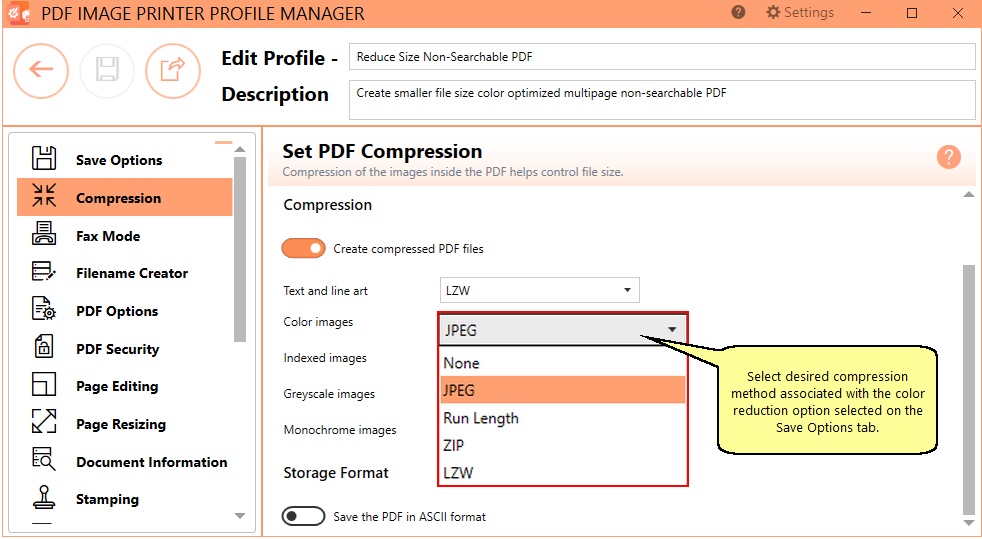
Lowering the Printer Resolution to Reduce Non-Searchable PDF File Size
Lowering the printer resolution works to reduce non-searchable PDF file size because each page is an image. A lower printer resolution means fewer dots per inch, or pixels, to store. Too low of a resolution, however, cause blocky and pixelated images with hard-to-read text.
The resolution the printer will use can be set from the Manage Printers tile on the dashboard.
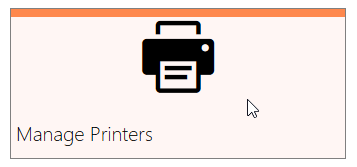
On the Print Management screen make sure your new profile is selected to be used when printing. Next, open the advanced settings using the down arrow in the row of icons to the right. It will change to an up arrow and additional settings, including Resolution, will appear.
Lower the resolution from the default of 300 dpi. When done, click the Save icon in the row of icons to commit your changes.
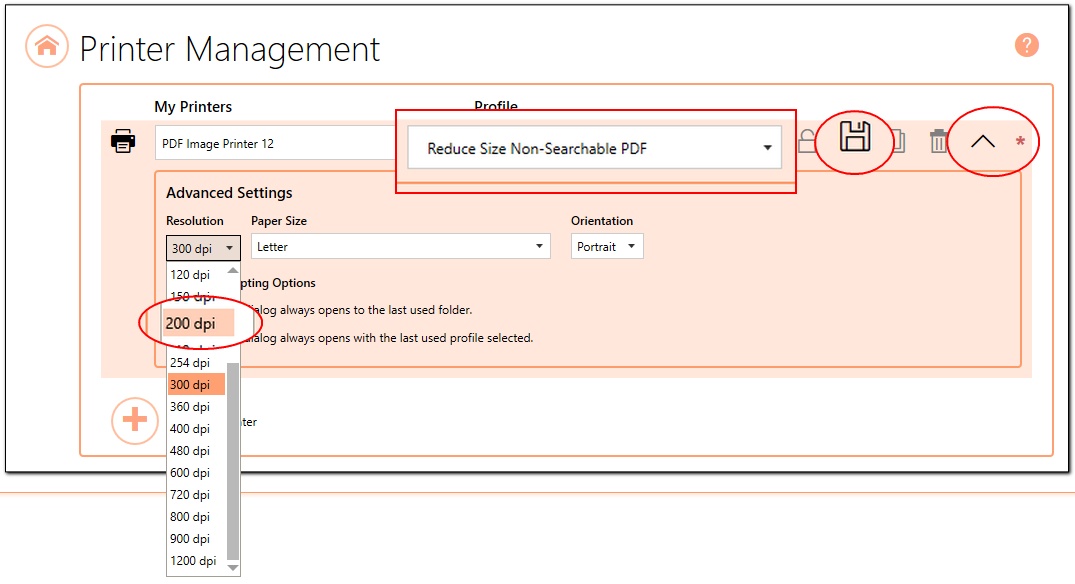
Saving and Using the Profile
Save your profile using the Save button in the upper left when your changes are complete. Print your document to the printer using this new profile to see how the changes will reduce your PDF image size.
Keep in mind that when reducing the file size of PDF images, always strike a balance between size and preserving document legibility and quality. Experiment with the different settings to see how they affect your file size and quality. And, as always, reach out to our support team with any questions, they’ll be happy to help you.
If you plan to use these settings regularly, you may wish to make this personal profile the default profile used by PDF Image Printer or Raster Image Printer.



